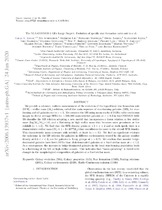| dc.contributor.author | Vaccari, Mattia | |
| dc.contributor.author | Leslie, Sarah K. | |
| dc.contributor.author | Schinnerer, Eva | |
| dc.date.accessioned | 2021-02-18T09:17:24Z | |
| dc.date.available | 2021-02-18T09:17:24Z | |
| dc.date.issued | 2020 | |
| dc.identifier.citation | Vaccari, M. et al. (2020). The VLA-COSMOS 3 GHz Large Project: Evolution of specific star formation rates out to z∼5. The Astrophysical Journal, 899(1) | en_US |
| dc.identifier.uri | http://doi.org/10.3847/1538-4357/aba044 | |
| dc.identifier.uri | http://hdl.handle.net/10566/5954 | |
| dc.description.abstract | We provide a coherent, uniform measurement of the evolution of the logarithmic star formation rate
(SFR) – stellar mass (M∗) relation, called the main sequence of star-forming galaxies (MS), for starforming and all galaxies out to z ∼ 5. We measure the MS using mean stacks of 3 GHz radio continuum
images to derive average SFRs for ∼ 200,000 mass-selected galaxies at z > 0.3 in the COSMOS field.
We describe the MS relation adopting a new model that incorporates a linear relation at low stellar
mass (log(M∗/M )<10) and a flattening at high stellar mass that becomes more prominent at low
redshift (z < 1.5). We find that the SFR density peaks at 1.5 < z < 2 and at each epoch there is a
characteristic stellar mass (M∗ = 1−4×1010M ) that contributes the most to the overall SFR density.
This characteristic mass increases with redshift, at least to z ∼ 2.5. We find no significant evidence
for variations in the MS relation for galaxies in different environments traced by the galaxy number
density at 0.3 < z < 3, nor for galaxies in X-ray groups at z ∼ 0.75. We confirm that massive bulgedominated galaxies have lower SFRs than disk-dominated galaxies at a fixed stellar mass at z < 1.2.
As a consequence, the increase in bulge-dominated galaxies in the local star-forming population leads
to a flattening of the MS at high stellar masses. This indicates that “mass-quenching” is linked with
changes in the morphological composition of galaxies at a fixed stellar mass. | en_US |
| dc.language.iso | en | en_US |
| dc.publisher | IOP Publishing | en_US |
| dc.subject | Galaxy evolution | en_US |
| dc.subject | Galaxy properties | en_US |
| dc.subject | Star formation | en_US |
| dc.subject | Scaling relations | en_US |
| dc.subject | Galaxy environments | en_US |
| dc.title | The VLA-COSMOS 3 GHz Large Project: Evolution of specific star formation rates out to z∼5 | en_US |
| dc.type | Article | en_US |

